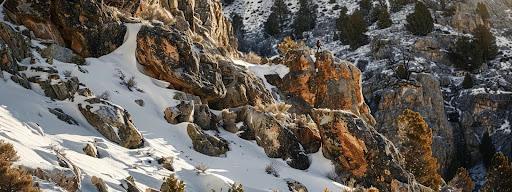
Essential Snow Safety Tips for the Sawtooth Mountains and Stanley, Idaho
Essential Snow Safety Tips for the Sawtooth Mountains and Stanley, Idaho
Winter adventures in the Sawtooth Mountains and Stanley, Idaho offer stunning landscapes, but they also present unique challenges. This guide provides essential snow safety tips for visitors and residents alike. Readers will learn about understanding local snow conditions, essential gear for winter activities, and avalanche awareness. The content covers safe movement techniques in snowy terrain and emergency response, equipping outdoor enthusiasts with the knowledge to enjoy the Sawtooth Range safely. Whether you're planning a day hike from a trailhead or a challenging climbing expedition, these tips will help ensure a safe and memorable experience in this beautiful moraine-shaped landscape.
Understanding Snow Conditions in the Sawtooth Mountains and Stanley, Idaho

Understanding snow conditions in the sawtoothcra Sawtooth Mountains and Stanley, Idaho is crucial for safe exploration. This section covers typical weather patterns and snowfall, identifying avalanche-prone areas near Thompson Peak and Mount Regan, and seasonal variations affecting safety. Knowledge of these factors helps visitors navigate the rugged terrain of North America's Payette River region and the Galena area responsibly.
Typical Weather Patterns and Snowfall
The Sawtooth Mountains and Stanley, Idaho experience significant snowfall throughout the winter months, typically from November to April. The region's high elevation and proximity to the Payette River contribute to its abundant snowpack, with average accumulations reaching several feet in the mountains. Visitors to the area, whether staying at a Sawtooth hotel in Stanley or exploring the surrounding forest and mountain terrain, should be prepared for rapidly changing weather conditions that can affect activities such as rafting or hiking in Stanley Town Square.
Identifying Avalanche-Prone Areas
In the Sawtooth Mountains and Stanley, Idaho, avalanche-prone areas often occur on steep slopes and in gullies, particularly near Thompson Peak and Mount Regan. The mountain range's unique topography, combined with heavy snowfall and fluctuating temperatures, creates conditions ripe for avalanches. Visitors staying at resorts or exploring the Galena Lodge area should be aware of these high-risk zones, especially when venturing into the backcountry. Understanding the terrain and monitoring the sky for weather changes is crucial for safe exploration in this stunning alpine environment.
Seasonal Variations and What They Mean for Safety
Seasonal variations in the Sawtooth Mountains and Stanley, Idaho significantly impact safety for outdoor enthusiasts. Winter brings deep snow to peaks like Redfish Lake Stanley and the Middle Fork Salmon River area, increasing avalanche risk for rock climbing and summit attempts. As spring approaches, warming temperatures can destabilize snowpack, creating hazardous conditions on popular routes and potentially affecting access to trailheads.
Essential Gear for Safe Winter Adventures

Exploring the Sawtooth Mountains and Stanley, Idaho's ski resorts and canyons requires proper gear for safe winter adventures. This section covers essential clothing, layering techniques, safety equipment for snow travel, navigation tools for winter terrain, and emergency kit preparation. These elements are crucial for navigating the challenging landscape around Galena Summit and ensuring a safe experience in the mountains.
Proper Clothing and Layering Techniques
Proper clothing and layering techniques are essential for safe winter adventures in the Sawtooth National Recreation Area. Visitors planning to snowshoe near alpine lakes or mountain bike in Stanley's high country should start with a moisture-wicking base layer, add an insulating mid-layer, and top with a waterproof outer shell. Guests staying at the Stanley High Country Inn Stanley ID can benefit from this layering system, which allows for easy adjustment to changing temperatures and activity levels while exploring the region's diverse terrain.
Must-Have Safety Equipment for Snow Travel
When venturing into the Sawtooth Wilderness or Wood River Valley, essential snow safety equipment includes avalanche beacons, probes, and shovels. Visitors staying at the High Country Inn Stanley ID should also carry snowshoes or skis for efficient travel through deep snow. In the rugged terrain near Stanley, Idaho, where elk roam freely, a well-stocked first aid kit and emergency communication device are crucial for addressing unexpected situations in remote areas.
Navigation Tools for Winter Terrain
Navigation tools are essential for safely traversing the snow-covered terrain of Idaho's Sawtooth Mountains. Visitors exploring the valley at high elevations should carry topographic maps, a compass, and a GPS device to maintain proper orientation in whiteout conditions. These tools prove invaluable when venturing off-trail or during unexpected weather changes, ensuring adventurers can locate fishing spots or return to their starting point safely.
Preparing an Emergency Kit
An emergency kit is crucial for winter adventures in the Sawtooth Mountains and Stanley, Idaho. Visitors exploring the Central Idaho Dark Sky Reserve or hiking near Stanley Lake should pack essential items such as extra warm clothing, high-energy snacks, a first-aid kit, and a multi-tool. For those enjoying recreation on Bald Mountain or venturing into remote areas of the Sawtooth Mountain range, including a headlamp, fire-starting materials, and an emergency shelter can prove invaluable in unexpected situations.
Avalanche Awareness and Prevention

Avalanche awareness and prevention are crucial for safe exploration of the Sawtooth National Forest and White Cloud Mountains. This section covers recognizing unstable snow signs, effective use of avalanche safety gear, local forecast resources, and the importance of safety training. Backpackers and visitors to the High Country Inn Stanley should prioritize these skills when venturing near hot springs or backcountry areas.
Recognizing Signs of Unstable Snow
Recognizing signs of unstable snow is crucial for safety in the Sawtooth Mountains, including areas near Pettit Lake, Sawtooth Lake, and Alturas Lake. Visitors should watch for recent avalanche activity, cracking or collapsing snow, and sudden temperature changes. In the Wood River and Boulder Mountain regions, wind-loaded slopes and steep terrain above 30 degrees pose increased avalanche risk.
How to Use Avalanche Safety Gear Effectively
Proper use of avalanche safety gear is crucial for backcountry enthusiasts exploring the wilderness near Stanley Lake or the central Idaho mining regions. Visitors should practice regularly with their avalanche beacons, probes, and shovels to ensure quick and effective deployment in emergency situations. When traversing areas near dams or mountain lakes, travelers must keep their beacons in transmit mode and conduct a group check before entering avalanche terrain.
Local Avalanche Forecast Resources
Local avalanche forecast resources provide crucial information for ski enthusiasts and outdoor adventurers in the Sawtooth Mountains and Stanley, Idaho. The Sawtooth Avalanche Center, located in the Sawtooth Valley, offers daily forecasts and observations specific to the region, including the Salmon River Mountains and surrounding pine-covered slopes. Visitors to this area of the United States should consult these forecasts regularly, as they provide detailed insights into snow conditions, weather patterns, and potential hazards across various elevations and aspects of the terrain.
Importance of Avalanche Safety Training
Avalanche safety training is crucial for anyone exploring the Sawtooth Mountains and Stanley, Idaho, especially near the Big Wood River and Mountain Village Resort Stanley. Participants learn to assess snow conditions, recognize wildlife signs, and navigate the vast acreage of avalanche-prone terrain. These skills are essential for making informed decisions and minimizing risk while enjoying the region's winter landscapes.
Planning Your Trip in the Sawtooth Mountains

Planning a safe trip in the Sawtooth Mountains requires careful preparation. This section covers researching trail conditions and weather, selecting safe routes for backcountry skiing, informing others about plans, and guidelines for solo versus group travel. Understanding these aspects helps visitors navigate the Sawtooth National Recreation Area's streams, trails, and fish habitats responsibly.
Researching Trail Conditions and Weather
Researching trail conditions and weather is crucial for safe exploration of the Sawtooth National Forest, especially in areas near salmon-rich streams and rocky cirques. Visitors staying at the Mountain Village Lodge Stanley should check local weather forecasts and trail reports regularly, as conditions can change rapidly in this alpine environment. The Sawtooth National Recreation Area's website provides up-to-date information on trail closures, snow levels, and potential hazards, helping hikers and skiers make informed decisions about their routes and timing.
Selecting Safe Routes and Destinations
Selecting safe routes and destinations in the Sawtooth Mountains requires careful consideration of the national recreation area's diverse terrain. Visitors should assess their skill level and choose paths that match their abilities, particularly when planning whitewater boating adventures on the Salmon River or hiking near granite peaks like Mount Heyburn. Local rangers and experienced guides can provide valuable insights on current conditions and recommend suitable routes that balance scenic views with safety considerations.
Informing Others About Your Plans
Informing others about hiking plans in the Sawtooth Mountains is crucial for outdoor recreation safety. Before venturing into the backcountry near Redfish Lake or exploring glaciers, visitors should provide detailed itineraries to trusted contacts. This information should include planned routes, estimated return times, and emergency contact numbers, enabling swift response in case of unexpected delays or incidents.
Guidelines for Solo vs. Group Travel
When planning trips in the Sawtooth Mountains, travelers should consider the benefits and risks of solo versus group travel. Groups offer increased safety near water bodies like Redfish Lake, with members able to assist each other in emergencies. However, solo adventurers can move more quickly and quietly, potentially enhancing wildlife viewing opportunities. Visitors staying at Redfish Lake Lodge Stanley ID should inform staff of their plans, regardless of group size, and carry appropriate safety gear for their chosen route.
Safe Movement Techniques in Snowy Terrain

Safe movement techniques in snowy terrain are crucial for exploring the Sawtooth Mountains and Stanley, Idaho. This section covers proper use of snowshoes and skis, group spacing and communication, techniques for traversing slopes safely, and managing fatigue and energy levels. Understanding these methods helps visitors navigate the area's challenging winter landscape safely and efficiently.
Proper Use of Snowshoes and Skis
Proper use of snowshoes and skis is essential for safe travel in the Sawtooth Mountains' snowy terrain. Snowshoes provide stability and flotation in deep powder, allowing hikers to access remote areas near Stanley Lake or the Salmon River. Skis offer efficient gliding on packed trails and open slopes, but require more skill to navigate steep or icy sections. Visitors should choose the appropriate equipment based on snow conditions, terrain, and personal experience to ensure safe and enjoyable exploration of the Sawtooth National Recreation Area.
Spacing and Communication in a Group
Proper spacing and communication within a group are vital for safe travel in the Sawtooth Mountains' snowy terrain. Group members should maintain a distance of at least 20 feet between each other when traversing avalanche-prone slopes, allowing time for reaction if a slide occurs. Clear, concise verbal and non-verbal signals should be established before setting out, enabling quick communication about potential hazards or changes in route. Regular check-ins and designated rest stops help ensure the group stays together and maintains awareness of each member's condition throughout the journey.
Techniques for Traversing Slopes Safely
Traversing slopes safely in the Sawtooth Mountains requires careful technique and awareness. Skiers and snowshoers should maintain a diagonal path across steep slopes, using their edges or crampons to grip the snow. When ascending, they should kick steps or use a zigzag pattern to distribute weight evenly and prevent sliding. On descents, users should lean slightly into the slope and take controlled, measured steps to maintain balance and reduce the risk of falls.
Managing Fatigue and Energy Levels
Managing fatigue and energy levels is crucial for safe movement in the Sawtooth Mountains' snowy terrain. Travelers should take regular breaks, hydrate frequently, and consume high-energy snacks to maintain stamina. Pacing is key; hikers and skiers should adopt a steady rhythm that allows for consistent progress without overexertion. By monitoring their physical condition and adjusting activity levels accordingly, visitors can reduce the risk of exhaustion-related accidents in challenging winter conditions.
Responding to Emergencies

Responding to emergencies in the Sawtooth Mountains requires quick thinking and proper preparation. This section covers crucial steps for avalanche survival, performing rescues with limited resources, contacting local emergency services, and administering basic first aid for cold-related injuries. Understanding these procedures is essential for anyone exploring the snowy terrain of Stanley, Idaho and its surrounding areas.
What to Do if Caught in an Avalanche
If caught in an avalanche in the Sawtooth Mountains, individuals should immediately attempt to move to the side of the slide and grab onto solid objects to avoid being swept downslope. As the avalanche slows, they should create an air pocket around their face and thrust an arm upward to signal their location. Once the snow settles, victims should remain calm, conserve energy, and listen for rescue efforts while attempting to slowly dig themselves out if possible.
Performing a Rescue With Limited Resources
Performing a rescue with limited resources in the Sawtooth Mountains requires quick thinking and adaptability. Rescuers should prioritize locating the victim using avalanche beacons, probes, or visual cues, then work systematically to excavate them. In the absence of proper tools, improvised equipment such as ski poles or tree branches can be used for probing and digging. Rescuers must work efficiently while maintaining their own safety, as time is critical in avalanche rescue situations.
Contacting Local Emergency Services
In emergency situations in the Sawtooth Mountains, contacting local emergency services is crucial. Visitors should carry a fully charged cell phone and be aware of areas with reliable service. The Stanley area is served by the Custer County Sheriff's Office and Search and Rescue team, which can be reached by dialing 911. For non-emergency situations, travelers can contact the Sawtooth National Forest Ranger Station for assistance and information.
Basic First Aid for Cold-Related Injuries
Basic first aid for cold-related injuries in the Sawtooth Mountains involves quick recognition and appropriate treatment. For frostbite, affected areas should be gently warmed using body heat or warm water, avoiding direct heat sources. Hypothermia requires immediate shelter, removal of wet clothing, and gradual warming with dry blankets or sleeping bags. In severe cases, rescuers should initiate skin-to-skin contact to transfer body heat while awaiting professional medical assistance.
Conclusion
Snow safety in the Sawtooth Mountains and Stanley, Idaho is crucial for safe exploration and enjoyment of this stunning alpine environment. Understanding snow conditions, having essential gear, being aware of avalanche risks, and knowing proper movement techniques are vital for winter adventures in this region. Proper planning, including researching conditions, selecting safe routes, and informing others of plans, significantly enhances safety for both solo and group travelers. In emergencies, quick thinking, knowledge of rescue procedures, and basic first aid skills can be life-saving, underscoring the importance of thorough preparation for anyone venturing into this beautiful but challenging winter landscape.

We support and protect conservation and recreation in the Sawtooth National Recreation Area.
Newsletter
Subscribe To Our Newsletter For Latest News
